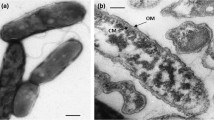Abstract
The isolation and properties of a novel species of pink-pigmented methylotroph, Methylobacterium thiocyanatum, are described. This organism satisfied all the morphological, biochemical, and growth-substrate criteria to be placed in the genus Methylobacterium. Sequencing of the gene encoding its 16S rRNA confirmed its position in this genus, with its closest phylogenetic relatives being M. rhodesianum, M. zatmanii and M. extorquens, from which it differed in its ability to grow on several diagnostic substrates. Methanol-grown organisms contained high activities of hydroxypyruvate reductase [3 μmol NADH oxidized min–1 (mg crude extract protein)–1], showing that the serine pathway was used for methylotrophic growth. M. thiocyanatum was able to use thiocyanate or cyanate as the sole source of nitrogen for growth, and thiocyanate as the sole source of sulfur in the absence of other sulfur compounds. It tolerated high concentrations (at least 50 mM) of thiocyanate or cyanate when these were supplied as nitrogen sources. Growing cultures degraded thiocyanate to produce thiosulfate as a major sulfur end product, apparently with the intermediate formation of volatile sulfur compounds (probably hydrogen sulfide and carbonyl sulfide). Enzymatic hydrolysis of thiocyanate by cell-free extracts was not demonstrated. Cyanate was metabolized by means of a cyanase enzyme that was expressed at approximately sevenfold greater activity during growth on thiocyanate [V max 634 ± 24 nmol NH3 formed min–1 (mg protein)–1] than on cyanate [89 ± 9 nmol NH3 min–1 (mg protein)–1]. Kinetic study of the cyanase in cell-free extracts showed the enzyme (1) to exhibit high affinity for cyanate (K m 0.07 mM), (2) to require bicarbonate for activity, (3) to be subject to substrate inhibition by cyanate and competitive inhibition by thiocyanate (K i 0.65 mM), (4) to be unaffected by 1 mM ammonium chloride, (5) to be strongly inhibited by selenocyanate, and (6) to be slightly inhibited by 5 mM thiosulfate, but unaffected by 0.25 mM sulfide or 1 mM thiosulfate. Polypeptides that might be a cyanase subunit (mol.wt. 17.9 kDa), a cyanate (and/or thiocyanate) permease (mol.wt. 25.1 and 27.2 kDa), and a putative thiocyanate hydrolase (mol.wt. 39.3 kDa) were identified by SDS-PAGE. Correlation of the growth rate of cultures with thiocyanate concentration (both stimulatory and inhibitory) and the kinetics of cyanase activity might indicate that growth on thiocyanate involved the intermediate formation of cyanate, hence requiring cyanase activity. The very high activity of cyanase observed during growth on thiocyanate could be in compensation for the inhibitory effect of thiocyanate on cyanase. Alternatively, thiocyanate may be a nonsubstrate inducer of cyanase, while thiocyanate degradation itself proceeds by a carbonyl sulfide pathway not involving cyanate. A formal description of the new species (DSM 11490) is given.
Similar content being viewed by others
Author information
Authors and Affiliations
Additional information
Received: 17 April 1997 / Accepted: 16 September 1997
Rights and permissions
About this article
Cite this article
Wood, A., Kelly, D., McDonald, I. et al. A novel pink-pigmented facultative methylotroph, Methylobacterium thiocyanatum sp. nov., capable of growth on thiocyanate or cyanate as sole nitrogen sources. Arch Microbiol 169, 148–158 (1998). https://doi.org/10.1007/s002030050554
Issue Date:
DOI: https://doi.org/10.1007/s002030050554




